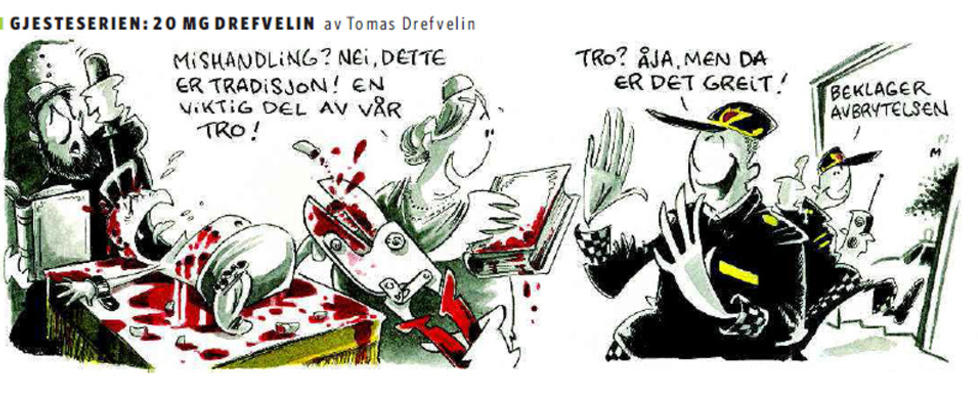|
Dagbladet (Norway, Bing translation) Dagbladet comic strip aroused international attentionArtist Thomas Drefvelin says that the drawing is not directed towards a particular religion or particular peoples. By Trude Ringheim A comic strip printed in yesterday's Edition of Dagbladet, [drew attention from] several foreign media. Artist Thomas Drefvelin has drawn the [satirical strip].
The Israeli newspaper Haaretz cites the Simon Wiesenthal Center that they perceive the drawing as anti-Semitic. [The Wiesenthal Center denounced “the blood libel cartoon published in Dagbladet.”
Rabbi Abraham Cooper, associate dean of the Simon Wiesenthal Center... demanded that the Norwegian government condemn the cartoon. “We call upon Norway’s leaders to denounce this incitement to hate and especially urge the ombudsman for children’s rights to denounce this outrageous denigration of a core Jewish rite dating back to the biblical times of Abraham,” Cooper said. “This cartoon has crossed all lines of decency and is dripping with hate and anti-Semitism,” said Dr. Moshe Kantor, president of the European Jewish Congress, in a statement. “We are now studying the possibility that this legally constitutes incitement and even a hate-crime and will therefore require legal action.” The European Jewish Congress said it was “carefully considering” the option of legal action over the cartoon. The Times of Israel, May 29, 2013] ... Defending the drawing -There is no doubt that the remedies here are powerful. But it is clearly an utterance that can pass in our columns, and in the public at large, "said Markussen and continues: -We understand [the] drawing [and] suggest it is not about a specific faith or not. I also can't read from the drawing [whether] it's a boy or a girl we see here. But the way I see the drawing, there is an attempt by cartoonist to illustrate what he conceives of the practice of genital cutting, but it's not that he points to particular peoples or religions in [his] drawing, said Markussen. [The woman is wearing a hat. Jewish women at religious services do not. Frames no[t] special -Some reading things into the drawing that I did not have the character or expressed, he said. -What is your intention? - I was trying to make a parody of religion-but it is not a particular or a specific religion or a specific people I drew, it is neither a boy or a girl baby, just a child. The drawing has a serious topic. General criticism of religion -The whole point is [w]hat the first police officer says. Police officer says: "faith? Oh, Yes, but then it's okay. " Therein lies my point that draw. Religion gets away with the worst thing just using that quote. One says only that "this is tradition" and "this is religion" and so should it somehow be okay. -What do you say to critics? -I have no anti-Semitic attitudes. It can be seen by my overall production, that at the base of everything I do, [is] humanism and the defence of the individual human being. Under all the rough humour, there is a defense for man, individuals and especially for defenseless children. -You take no criticism for [the cartoon]? -I'd maybe parodied shapes in your drawing even more than I do, to emphasize that this is not specific to a particular religion. -So this is not an attack on Jews? -No. Jew hatred is reprehensible. This would never occur to me to draw a strip to create hatred against a people or against individuals. Let me repeat. My criticism of religions are generic, nothing else, "said [artist] Tomas Drefvelin. Point to the cop -The point in the drawing as we see it, the police officer and his statements, that if one of the actions refers to religion or tradition, so one can get away with a lot. Markussen emphasizes: -I perceive as the cartoonist said not intend going to the attack on any particular religion or special people. That's a key point here. -Then the drawing is not anti-Semitic? -No, it's not. Dagbladet is a liberal newspaper, our attitudes are so far from being anti-Semitic as it is possible. Anti-Semitism is absolutely reprehensible for Dagbladet, as also for the cartoonist, Markussen [said]. |
||||||||







